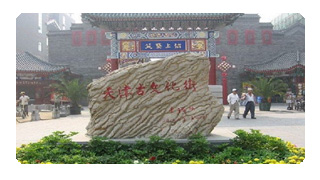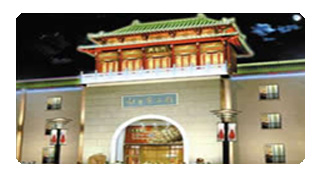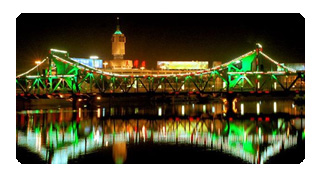Jin, for short of Tianjin, the third largest city
of China and called as the diamond of Bohai Sea, is
the economic center in the north of China, the international
port city, and also an ecological city. Located in
the northeast of the North China plain, Tianjin is
the fourth municipality directly under the Central
Government together with Beijing, Shanghai, and Chongqing.
In addition, it is also one of the fourteen coastal
cities in China. It is about 120 km from Tianjin to
Beijing, and it is one of the important and famous
history and cultural cities.
Tianjin, located in the center of economic circle
of Bohai, is the biggest coastal open city, the birthplace
of modern industry, the earliest coastal open city,
the centre of the sea and industrial. As China's largest
industrial center, Tianjin build a all-sided system
of industry, with the machinery, electronics, textile,
chemical industry, metallurgy, food, and so on, as
its mainstay. In the north China, Tianjin is the busiest
commercial area and material distributing center.
In addition, Tianjin has rich oil, gas, and sea salt
resources.
It is also a key transport hub to the land and the
sea. For a long time, Tianjin keep trade contacts
with more than 170 countries and regions and more
than 300 ports, and it is the nearest eastern starting
point to connect Euro-Asia Continental Bridge.
Tianjin now has 15 subordinate area and 3 counties
with a population of more than nine million people.
Tianjin is a famous historical and cultural city.
It has many places of cultural relics, the famous
historical and cultural sites.The major tour resources
there include Huangyaguan Great Wall, Tianjin radio
and television tower, the home of Huo Yuan Chia, Dagu
Fort, etc.
 Ancient
Cultural Street
Ancient
Cultural Street
Ancient Cultural Street is composed of three parts
which are the Gongnan Street, the Gongbei Street,
and the Gongqian Square. The street is about 580 meters
long and 7 meters wide with the Tianhou Gong in the
center. It is the biggest old building with half-timbered
in Tianjin today. It was officially opened on January
1st, 1986. The street not only has about 100 stores,
but also run the old books, the old jade, the jewelry
enamel, and so on. Besides, up and down the street
there are many small shops and vendors that sell all
sorts of food and handicrafts, such as the Ice Sugar
Gourd, the sweets, the sweet potato, ect. There you
can also enjoy yourself the interesting of have a
look of the performance of the tea culture. If you
want to appreciate the taste of Tianjin, ancient,
and the taste of the culture, you should and need
to have a visit the Ancient Cultural Street.
 Food
Street
Food
Street
Nanshi Food Street, one of the top ten scenic spots
in Tianjin, is located in the old urban area of Tianjin.
There are more than 100 stores that converge various
types of food flavors from all the places in China.
There are foods from Sichuan, Shandong, Guangdong,
Hunan, Jiangsu, Zhejiang, and many others. When you
arrive in Tianjin, you can find it in one of the old
shopping areas of Tianjin.
All in all, the Nanshi Food Street is well known all
throughout China and every year many people go there
to have a visit and stop to have a taste.
 Liberation
Bridge
Liberation
Bridge
The Liberation Bridge is a bridge built with the steel
structure and it can be open. The bridge is built
between the Tianjin railway station and the north
road of Jiefang Road. And it is not only one of the
landmark buildings in Tianjin, but also the hinge
combines the Hebei, Hedong and Heping districts, and
links the whole Tianjin.
The bridge was firstly built in 1902, and then it
was rebuilt in 1923, later the bridge was officially
built in 1927. The name of the bridge is WanGuo Bridge
at the beginning, next it was renamed as Liberation
Bridge. The whole bridge is about 97.64 meters long
and 19.5 meters wide. There are three holes in the
bridge. Therefore, if you have a chance to have a
look of many ships crossing the bridge, that will
be exactly a spectacular.



